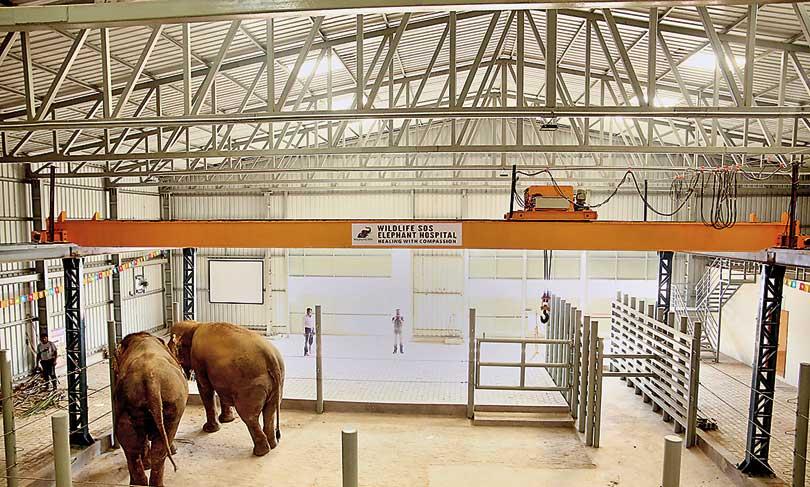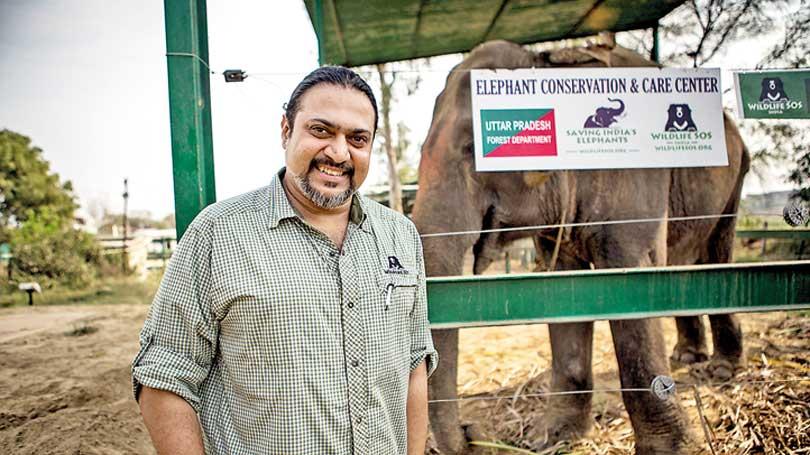Reply To:
Name - Reply Comment

 Home to some 50-60% of the total elephant population in Asia, India is a country of paramount importance for the survival of the species. Excessively used in the entertainment industry, elephants in India encounter countless beatings and undergo stressful periods before they are caparisoned and ‘used’ in these occasions. As such, elephants in India – similarly to their Sri Lankan counterparts –are plagued by a plethora of issues owing to poaching, habitat loss and use in the entertainment industry. Yet, adding a ray of hope to the lives of these gentle giants, a group of wildlife enthusiasts at Wildlife SOS – a non-profit organisation founded in 1995 – managed to establish India’s first-ever elephant hospital last November. From then to now, the hospital has rescued as many as 26 elephants from abusive tourist attractions such as circuses, temples, riding camps and private owners.
Home to some 50-60% of the total elephant population in Asia, India is a country of paramount importance for the survival of the species. Excessively used in the entertainment industry, elephants in India encounter countless beatings and undergo stressful periods before they are caparisoned and ‘used’ in these occasions. As such, elephants in India – similarly to their Sri Lankan counterparts –are plagued by a plethora of issues owing to poaching, habitat loss and use in the entertainment industry. Yet, adding a ray of hope to the lives of these gentle giants, a group of wildlife enthusiasts at Wildlife SOS – a non-profit organisation founded in 1995 – managed to establish India’s first-ever elephant hospital last November. From then to now, the hospital has rescued as many as 26 elephants from abusive tourist attractions such as circuses, temples, riding camps and private owners.
Against this backdrop, Daily Mirror takes a closer look at this one-of-a-kind facility treating pachyderm patients.
Inside Wildlife SOS elephant hospital The hospital sits at Mathura in Uttar Pradesh and spans some 12,000 square feet. From portable x-ray to ultrasound machines, wireless digital radiology, laser therapy, in-house pathology lab, footcare tools and a medical hoist for comfortably lifting disabled elephants and moving them around the treatment area, the facility is fully-equipped to best serve its patients. In addition, an interpretation centre and an observation window for visiting veterinarians, biologists and elephant caretakers from around the world have been established. For regular check-ups and speciality treatments, there is a jumbo-sized digital weight scale, laboratory testing facilities and a hydrotherapy pool. When rescued elephants are first brought to the hospital, they are given a thorough evaluation by a veterinarian attached to the centre.
It definitely isn’t an easy task for a non-profit organisation to establish a facility of the kind. Although a myriad of challenges were thrown at it, the team at Wildlife SOS brave them with courage and confidence.
“Rescuing and caring for animals are always a financial challenge whether it is purchasing food or medicines for animals, treatment, field equipment, fuel and maintenance or even staff salary,” said Karthik Satyanarayan, Chief Executive Officer and co-founder of Wildlife SOS. While the idea of designing the hospital was conceived three years prior to the inauguration of the hospital, more than a year was dedicated for designing the layout.
“We wanted it to be the best layout for a large animal such as an elephant. After that, of course, were the finer details which included the choice of raw materials. As we expect this facility to have many captive elephants as its patients, that have poor feet and frightened demeanour, we had to factor all of that in.
This is why some of our infrastructure is built keeping these in mind such as the Protected Contact Elephant Restraining Device and the medical hoist. Furthermore, we have relatively simple but efficacious treatment solutions in place like a hydrotherapy pool that aid in healing joint conditions.”
Just five months after its establishment, the hospital started receiving patients from outside the city as well. Two of them are Holly and Luna. Holly was an elderly, blind, begging elephant that arrived at the hospital last December while Luna, another begging elephant suffering from chronic ailments was hospitalised in early February. Holly is a former street-riding elephant that was taken away from its private owner. When she was rescued, her body was covered with chronic untreated abscesses. Holly is now receiving the medical care she always needed. The veterinary team is treating her arthritis with cold laser therapy and therapeutic ultrasonography – a technique using echoes of ultrasound pulses to delineate objects or areas of different density in the body. The team will also be attending to her abscessed wounds on a daily basis until she is healed.
Although wildlife enthusiasts are working tirelessly for the well-being of these creatures, elephants continue to be used, quite intensely, for entertainment purposes in India. In Kerala, temple festivals are elaborate and exotic and many of them revolve around the presence of elephants to honour the deity. Elephants held in captivity have often been malnourished and abused to the point they go through a stressful period in their lives. This trauma often leads to them turning out to be aggressive.
“There are two major loopholes that work against elephant conservation and welfare,” Mr. Satyanarayan said. “One is the proviso to Section 40 (2A) and (2B) which state it is not important for elephant owners to furnish/declare a certificate if the elephant has been acquired through inheritance. Secondly, the penalty under the Prevention of Cruelty to Animals Act of 1960 for any act of cruelty committed on elephants or any other wild animal is just INR 50 which is preposterous!”

In 2018, Sri Lanka witnessed the deaths of over 275 elephants as a result of railway accidents, poaching, falling into wells and due to the aggravating human-elephant conflict. Although fencing and demarcating boundaries for these gentle giants were discussed, humans continue to encroach into their habitats thus giving little or no chance for co-existence. Damaged houses and crops add to the burden of most underprivileged families in rural hamlet who view these giants as threats. As a result, they are treated with bullets and the lethal ‘hakka-patas’ (a mixture of explosive matter).
Project Elephant, 1992, is the greatest initiative taken by the Indian Government that focuses both on conservation of wild elephants and welfare of captive elephants.
“As much as Project Elephant sounds effective on paper, its implementation remains largely thin,” said Mr. Satyanarayan. “Rampant deforestation for developmental projects leading to habitat fragmentation still remains one of the biggest threats to wild elephants. Oftentimes, frustrated farmers and locals living on these fringes of elephant habitats are ill-equipped to handle the human-elephant conflict that threatens the life of the animal as a result of mob furry.”
He said creating a safer and conducive atmosphere for elephants begins with viewing conservation more holistically. “To keep humans tolerant of elephants, it is vital to send across the message that the fate of our forests is tied with that of elephants. Elephants are keystone species and have, through their long-ranging, migratory and dietary habits, engineered our forests. Once they cease to exist, no other species can replace the ecological niche created, and the entire ecosystem could be altered in deeply-concerning ways with invasive species.”
India is home to a variety of endemic species that have lately been threatened due to human interferences. Quite interestingly, the hospital also ministers to animals such as sloth bears and leopards. According to Mr. Satyanarayan, Wildlife SOS’ greatest accolade has been successfully ending the illegal and barbaric practice of dancing bears in India.
“We rescued over 628 endangered sloth bears from illegal custody while helping the nomadic communities with sustainable alternative legal livelihoods to help establish a model in place for sustainable conservation solutions. We did this in partnership with the indigenous communities so both people will not need to exploit bears anymore.”
Wildlife SOS also works with leopards, Asiatic black bears (moon bears) and Himalayan brown bears; three species that are in intense wild animal–human conflict situations in India, particularly in the States of Jammu and Kashmir (black bears, brown bears and leopards) and Maharashtra (leopards). Moreover, Wildlife SOS runs two rescue centres for black bears in Kashmir and one for leopards in Maharashtra.

The relationship between mahouts and elephants hinges on how the two-legged treat the four-legged. Armed with bullhooks and usually well-versed in ‘jumbo language,’ these mahouts do everything from feeding their four-legged mates to washing them and ensuring they don’t go haywire. But whether these mahouts treat elephants in a humane manner remains a question.
According to Mr. Satyanarayan, elephants are trained using the traditional form of management that involves pain, fear and intimidation.
“This eventually breaks the majestic animal’s spirit, forcing it to cooperate with the owners or the handlers,” he said. “At Wildlife SOS, we encourage the use of positive reinforcement techniques which are ethical and humane while helping mahouts form trusting bonds. Wildlife SOS has, in the past, conducted workshops with elephant keepers from various States and trained them in good husbandry practices and humane management of elephants. We also launched a training manual for elephant keepers in both Hindi and English languages that could serve as a go-to reference material for elephant keepers.”
Wildlife SOS mulls over providing specialised veterinary treatment to injured, sick or geriatric elephants. As the doors of the WSOS elephant hospital are open to practitioners and students world over, they also aim at developing more interest among conservationists on the plight of the Asian elephant and push for concerted action.
“We believe that through the Wildlife SOS elephant hospital we will be able to make contributions to the behavioural studies, veterinary sciences and pathology of Asian elephants, and contribute towards framing better conservation policies,” he said.
Pix courtesy Wildlife SOS